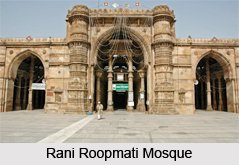 ani Roopmati Mosque is a famous religious place situated towards the north of the city of Ahmedabad, Gujarat. It is a historical monument built in the medieval era in the Mirzapur area of Ahmedabad.
ani Roopmati Mosque is a famous religious place situated towards the north of the city of Ahmedabad, Gujarat. It is a historical monument built in the medieval era in the Mirzapur area of Ahmedabad.
Construction of Rani Roopmati Mosque
Rani Roopmati Mosque was erected in the period 1430 to 1440 AD, the latter part of Ahmed Shah I"s reign in Gujarat. Constructed by the Sultan of Ahmedabad Mahmud Begada, it is named after his Hindu wife Rani Roopmati, whom he had married after the death of Qutubuddin. Before getting married to Mahmud Begada, Rani Roopmati was the princess of Dhar. Her tomb is located right next to the main mosque. The mosque presents a fine blend of the Indo-Saracenic architectural style and stands as an example of the extraordinary craftsmanship of Gujarat.
Architecture of Rani Roopmati Mosque
The Rani Roopmati Mosque is another fine example of the Indo-Saracenic blended architectural style. The mosque measures 105 feet long, 46 feet broad and 32 feet high. A high central arch, 3 imposing domes, slim minarets, carved galleries and an exquisite "mihrab" are the high points of attraction of the mosque. The three domes are supported by pillars and are interconnected by a flat roof. The central dome is elevated to provide natural illumination in the mosque, avoiding the glare of the sun. The ceiling of the dome is beautified with the Hindu style patterns. The prayer hall of the mosque is of great aesthetic value, consisting of exquisite carvings.
The domes are supported with rows of 12 pillars each. The smaller domes at the front and the rear of the bigger domes as well as the four corners of the mosque rise in gentle crescents that lend gentility to the mosque. The central section is an elevated level that rises above the small flanks and provides for a pierced clerestory, which carries the dome above.
Rani Roopmati Mosque is popularly known as Masjid-e-Nagina, seeming like an architectural jewel amongst the monuments in Ahmedabad, owing to its beautiful configurations. The mosque lost one of its minarets in the natural calamity that affected the Ahmedabad city in the year 1818 AD.
Related Articles:
Monuments in Ahmedabad, Monuments of Gujarat
Indian Historical Monuments
Ahmedabad
Rani Roopmati
Indo-Saracenic Architectural Style
Medieval History of Gujarat
History of Ahmedabad
Mosques in India



















